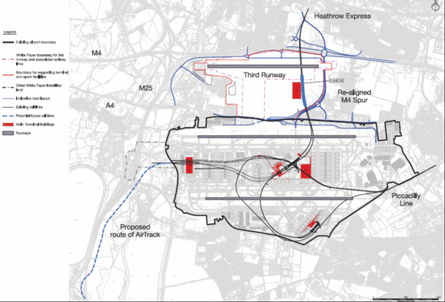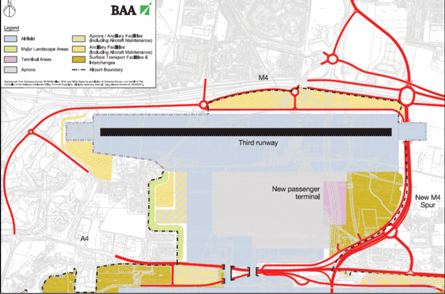Industrial leaders in the UK including the Confederation of British Industry, British Airways, Virgin Atlantic and airport operator BAA have today (22 November) collectively voiced strong support for a third runway at London Heathrow after the Government initiated a public consultation on the issue.
BAA chief executive Stephen Nelson says the plans his company are putting forward for consultation are much the same as they were two years ago: they include a 2,200m runway on Heathrow’s northern side, located parallel to the two existing runways, expanding the airport boundary considerably, and the addition of a new terminal in the airport’s north side.
 |
|---|
The future of London's Heathrow |
If the industry was to receive everything it is proposing, with no restrictions, Heathrow’s capacity would be expanded from the present Government-capped 480,000 air transport movements per year to 702,000.
Heathrow’s current runways are operating at 99% of capacity, according to British Airways chief Willie Walsh, who spoke during a joint briefing at the London stock exchange today.
This leads to flight cancellations whenever strong winds or poor visibility affect the airport, and is already driving business away from UK, he says.
The fact that the new runway, if approved, would not be operating until 2020 means the decision will come far later than it should have done, says CBI director general Richard Lambert. But he insists that hope of future improvement in Heathrow’s operational efficiency will encourage global businesses to keep their major operations in London and the UK southeast.
Southeastern UK needs two more runways, according to a Government study into UK aviation infrastructure begun in 2000, one at Heathrow and the other at London Stansted.
 |
|---|
A close-up of the new terminal and runway |
Virgin Atlantic chief executive Steve Ridgway said during today’s briefing that capping Heathrow “isn’t green”. He says: “It just shifts business to our competitors.”
Paris Charles de Gaulle and Amsterdam Schiphol already have more runways than Heathrow despite handling fewer passengers, and these cities stand to gain from continued Heathrow restrictions.
BAA hopes to gain approval for mixed-mode operation – enabling departures and arrivals to be performed on the same runway – which could potentially allow Heathrow to perform 540,000 annual air traffic movements.
Chief executive Nelson says he does not see that maximum being achieved before 2015, but permission to operate mixed-mode, even without a lifting of the movement cap, would give the airport “resilience” and provide a capacity margin.
Source: FlightGlobal.com
















